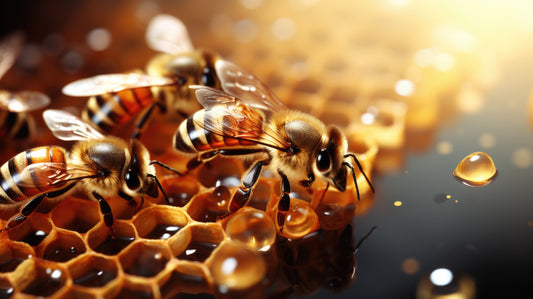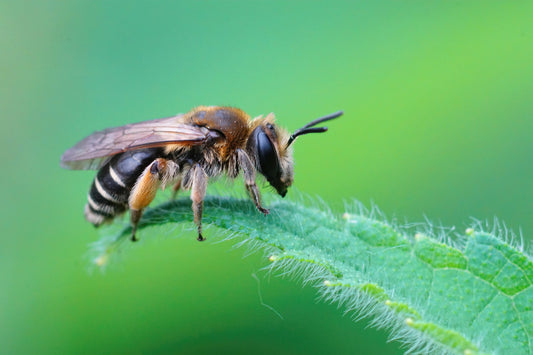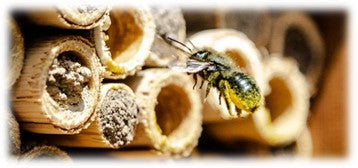
Welcome to the fascinating world of solitary bees! Often overlooked in favor of their more social counterparts, these unsung heroes of the pollination world are a vital part of our ecosystem. In this blog, we will delve into the intriguing life of these independent insects, exploring their habits, habitats, and the crucial role they play in our environment. So, let’s embark on this journey together, shedding light on the solitary bees, the silent workers of nature.
Unlike the well-known honeybee, which lives in large, buzzing colonies, a solitary bee is a bit of a lone ranger. These bees don’t produce honey or beeswax, nor do they live in hives. Instead, each female solitary bee is a queen in her own right, building and provisioning her own nest without the help of worker bees. They are the introverts of the bee world, living out their lives mostly alone. Solitary bees are diverse and can be found in various habitats worldwide. Despite their solitary nature, these bees are some of the most efficient pollinators on the planet, playing a crucial role in maintaining biodiversity and helping our gardens grow.

Raising solitary bees can be challenging due to their unique lifestyle and breeding habits. Unlike honeybees or bumblebees, solitary bees do not live in colonies, making it difficult to manage and monitor them. They also have specific nesting requirements, often preferring to nest in the ground, hollow plant stems, or pre-existing cavities like beetle holes or abandoned snail shells, which can be hard to replicate in a controlled environment. Additionally, solitary bees are more susceptible to environmental changes and pesticides, which can negatively impact their survival. Furthermore, they have a short lifespan, usually only living for a few weeks to a few months, which makes breeding and maintaining a population more difficult.
Despite the challenges, raising solitary bees can be achieved with careful planning and consideration. Providing a suitable habitat is crucial. This can be done by creating a bee house with small tubes or drilling holes into untreated wood, which mimics their natural nesting environment. It's also important to provide a variety of native flowering plants for food, ensuring a continuous bloom throughout their active season. Avoiding the use of pesticides in your garden is also essential as these can be harmful to solitary bees. Regular monitoring of the bee house can help detect any potential issues early on, such as parasites or disease. Lastly, understanding that solitary bees have a short lifespan and accepting that population growth will be gradual is key. With patience and dedication, you can successfully raise solitary bees and contribute to the preservation of these important pollinators.
Research and identify the solitary bee species that are native to your region to begin, so that you know what to expect. Different species have specific nesting requirements and foraging preferences. Understanding their needs will help you provide suitable habitats and food sources.
There are numerous species of solitary bees found worldwide. Mason bees are known for their exceptional pollination abilities. They construct nests using mud or plant material, hence their name. They are often blue or metallic in color and are active in early spring. Leafcutter bees are named for their behavior of cutting circular pieces of leaves to build their nests. They use these leaf pieces to line their nest cells. They are excellent pollinators and are often seen in summer months. Mining bees are ground-nesting bees that create tunnels in the soil for their nests. They are important early spring pollinators and can be found in a variety of colors and sizes. Carpenter bees are known for their ability to excavate tunnels in wood, such as dead trees or wooden structures. They are larger in size and can sometimes be mistaken for bumblebees. They are active in spring and summer. Sweat bees are a diverse group of solitary bees that are attracted to human sweat, hence their name. They are small in size and can be found in a wide range of colors. They are active throughout the summer months. Blue Orchard Bee species is an excellent pollinator of fruit trees. They are known for their metallic blue or black coloration. These are just a few examples, and there are many more native solitary bee species found across different regions of the United States, and the world.

Now that you know WHAT Solitary bees are, let’s talk about how to get them in your area! Building a solitary bee nest, also known as a bee hotel, is a relatively simple process. First, you must choose your materials. You can use untreated wood, bamboo, or even a pre-made bee house. If you're using wood, drill holes of various sizes (between 2mm and 10mm in diameter) about 3/4 of the way into the wood. The holes should be smooth and clean to prevent injury to the bees. Once you are finished building or purchasing a solitary bee nest, you need to figure out a good location. Choose a sunny location that's protected from wind and rain. The nest should be placed at least a meter off the ground, facing south or southeast to catch the morning sun. You can hang it on a wall, fence, or tree. Make sure it's secure and won't swing or spin in the wind. Make sure to clean out the nest at the end of each season to prevent disease and parasites. You can do this by removing the old tubes or drilling out the old wood. Also, make sure to plant native flowering plants nearby. Some good areas to place your solitary bee hotel can be places like: gardens, orchards and fruit tree groves, farm or agricultural areas, and natural areas like a wide-open meadow with a plethora of flower species. This will provide a food source for the bees. Remember, it may take a while for the bees to find and start using your bee hotel, so be patient.
After constructing a nest, the female solitary bee collects pollen and nectar to create a food source for her offspring. She lays an egg on top of the food provision and seals the chamber. The larva hatches from the egg and feeds on the stored food until it pupates and eventually emerges as an adult bee. Solitary bees are important pollinators, just like honeybees and bumblebees. They play a crucial role in pollinating flowers and crops, contributing to ecosystem health and food production. Some examples of solitary bees include mason bees, leafcutter bees, and mining bees. Creating suitable habitats for solitary bees, such as providing nesting materials like hollow stems or bee hotels, can help support their populations and enhance pollination in gardens and landscapes.
Remember, raising solitary bees is about creating suitable habitats and providing resources for their natural behavior. It is important to prioritize native species and avoid introducing non-native bees into ecosystems where they may become invasive. By supporting solitary bees, you contribute to pollination and biodiversity conservation.






